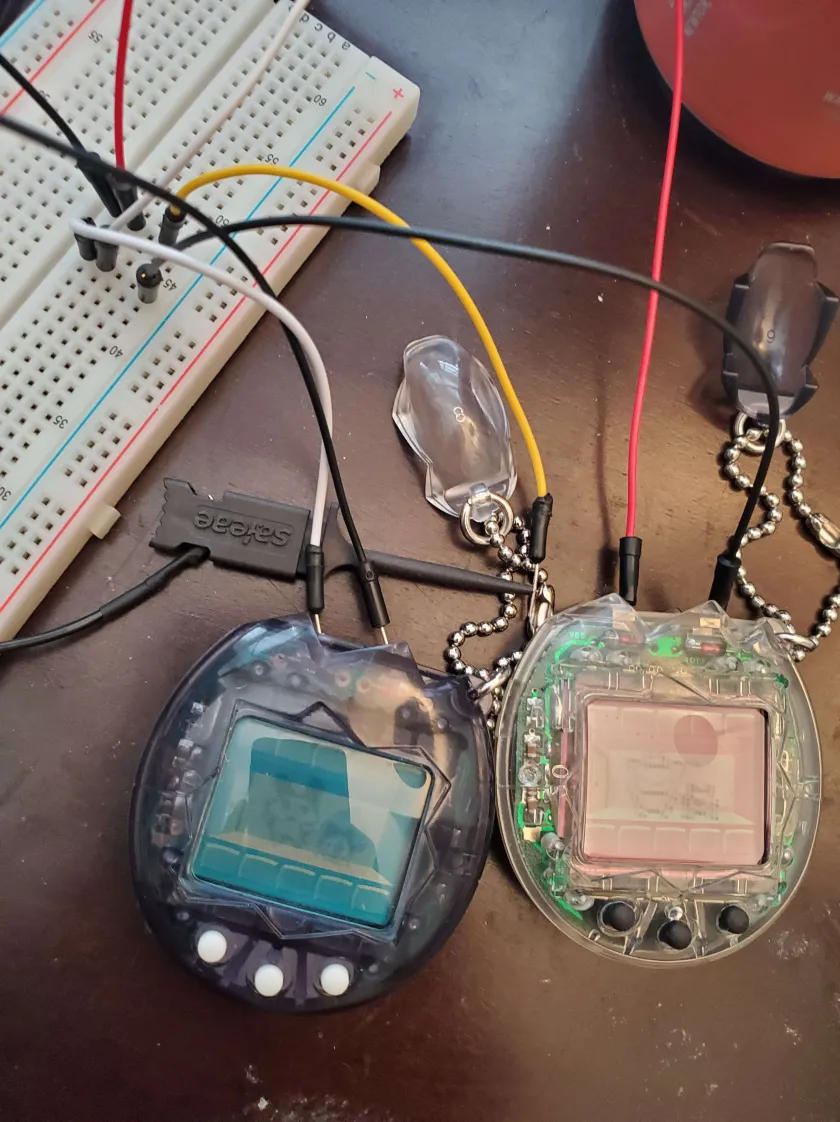
I spent a fair few months of 2023 playing the Osutchi/Mesutchi. These are probably my favorite vintage-era Tamas -- they feel GREAT, plastic and buttons feel good, UI response is nice and snappy. The characters are pretty much all cute, and your ability to win the game is not RNG-based. I'm not a big fan of the Connection or color-era Tamas, so the simplicity of these devices is a big draw for me. Please don't send me hate mail for this.
Anyway, fresh off the heels of my P1 ROM datamining project, I was still eager to do some Tama hacking. What I landed on, was to try and figure out how the breeding protocol for the Osu/Mesu work at a technical level. I thought it might be cool if I could build a device that can spoof the breeding process, so that I can get any outcome I want -- like an A-Com for Digimon. I never ended up doing this though.
The setup for this is that I hooked up the Osu and Mesu to a breadboard, and then added a Saleae logic analyzer that could watch the interaction. On the Osutchi, the left terminal is signal, and the right terminal is ground. Then on the Mesutchi, the right terminal is signal and the left signal is ground. Therefore, when you connect the Osutchi/Mesutchi together, the signal terminals connect, and the ground terminals connect, and they are able to talk. This is also how Digimon work -- this is already documented online, so I assumed (correctly) that Osu/Mesu work the same way. The setup is shown below -- the Saleae is connected to the signal ground ends.

The breeding process looks like this:

There is a handshake at the beginning that is determined by the characters you have on the Osu and Mesu. More on that later. Then there are 4 points in time where you see two short pulses (presumably one from Osu, one from Mesu). I assume this is some kind of sync or heartbeat. I assumed that the Osu sends the first pulse and the Mesu sends the second pulse, although I don't think I ever really confirmed this.
Roughly, these occur at the following points in the mating process:
As I mentioned, the first thing that the Osu/Mesu send to each other (once you select the Breed option on both the Osu/Mesu, then press the button again to confirm -- so this is before the OK sign appears on the screen), is this variable handshake. My belief is that this handshake consists of 3 parts:
So based on this, I concluded that the babies you get from breeding Osu/Mesu are completely determined on what the parents are. There is no randomness in the process -- if there were, that would have to be communicated on the line somehow and I saw no real evidence of that.
I think the best way to capture my results, at least qualitatively, is with a table. The timing here appears to be important. Note that I didn't always take screenshots at the same zoom scale, so the pulse size may appear to be different between breeding runs -- this is just because I'm sloppy, the pulse sizes were always consistent.
| Osutchi | Mesutchi | Result | Saleae Capture | Comments |
|---|---|---|---|---|
| ChoMametchi | ChoHimetchi | PuchiTeletchi | 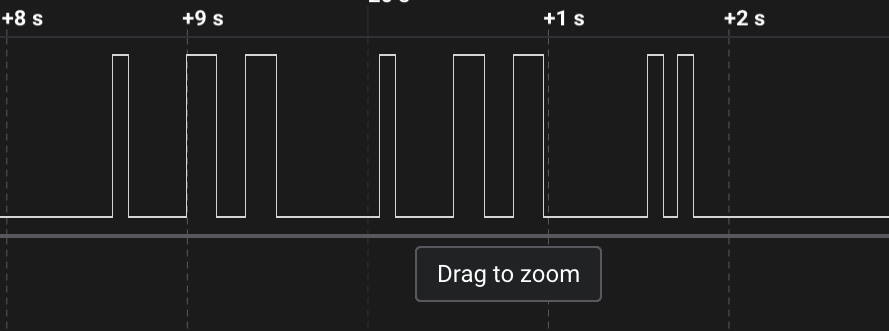 |
Observe the the symmetry here -- the pulses identify the Osu/Mesu characters are the same. This is likely because these adults are both the TMP 4 ones. |
| ChoMametchi | Pyonkotchi | PetitChocotchi |  |
Note that the left side is the same as the previous ChoMametchi/ChoHimetchi pair, but the right side is different. From this I concluded that the left side is the Osu character, and the right side is the Mesu character. The Fandom wiki indicates that this is an impossible result and that I should have gotten either TMP 1 or TMP 4 babies here. Clearly, the Wiki is wrong! Somebody should, eventually, run all the different combinations of characters, tabulate the results, then update the wiki. |
| Kabutchi | Bunkotchi | PetitChocotchi |  |
I had assumed that since Pyonkotchi and Bunkotchi are both considered "Group A" adults for TMP 1, meaning that they produce the same children (so are basically the same character from the breeding perspective), they would look the same on the wire. This turned out to be false as you can see -- Bunkotchi has an additional short pulse. So at least in theory, there could be cases where Pyonkotchi and Bunkotchi actually don't produce the same children. |
| Kabutchi | Pipotchi | PuchiTeletchi |  |
Again we see that the TMP 3 Osu and Mesu look the same on the wire. And, we see that the pattern matches what we saw when we bred Kabutchi earlier. |
| Bunbuntchi | Kikotchi | Teletchi |  |
As expected, the Osu side looks identical to what Bunkotchi looked like a few generations ago. |
| Marumimitchi | Mimikotchi | PetitChocotchi | 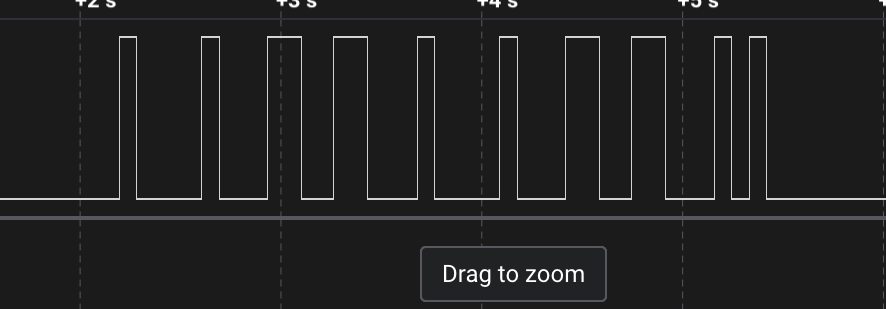 |
Osu and Mesu look the same on both sides, as expected. |
| Megatchi | Gankotchi | Kakutchi |  |
|
| Billotchi | Bilkotchi | PetitChocotchi |  |
|
| Pyonchitchi | Pyonkotchi | Tsubutchi | 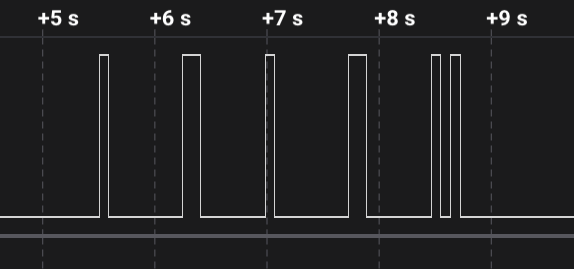 |
As expected, Osu and Mesu signatures are the same |
| Kiwitchi | Piratchi | Teletchi |  |
Again, this is not the result you would expect from looking at the Wiki. Also, I observed something strange happening with one of the sync/heartbeats during this breed: 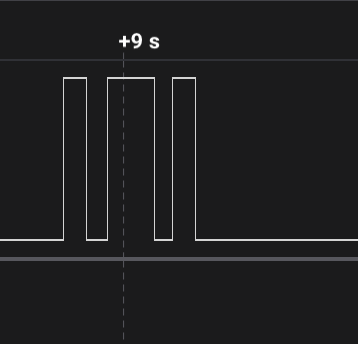 I never saw this happen in any other breed, but I told myself that it was just a strange glitch that didn't affect anything. Pure copium I never saw this happen in any other breed, but I told myself that it was just a strange glitch that didn't affect anything. Pure copium |
Technically, to fully complete my survey, I should have gotten Hiratchi. Based on what you can see in this table, I think it's reasonable to conclude that Hiratchi would look the same as Piratchi on the wire -- but you never know!
For people who are interested, (TBD FIGURE OUT WHERE TO PUT THIS) is a zip file containing all the captures I took during the mating processes. You should be able to figure out what was what based on the filenames. Open the .sal files in the Saleae Logic program (I believe this is free and you don't need a Saleae device to download it).
In the course of running this project, I needed a reliable way to get each TMP 1 character type, since those are care-based. Recall that for vintage Tamas, you get care mistakes when happy or hungry hearts are allowed to empty, the Tama calls for attention, and you let 15 minutes pass. The care mistake is registered when the attention sign turns off. You can also get care mistakes when the Tama goes to sleep -- if you leave the lights on long enough that the attention light goes off (I forget how long this takes -- 15 minutes? an hour?) a care mistake is registered. A discipline mistake is when the Tama calls for attention but won't eat or play, so you need to discipline it -- but you instead wait for the attention light to go off. Here is what worked for me:
I did not test what the variability in conditions were, I just found strats that worked for me personally. I don't know if the care mistakes / discipline mistakes are cumulative or if they reset between stages. I'm actually not sure if the Osu/Mesu use discipline mistake (which is how the P1/P2 work) or if they actually take into account how much of the discipline bar was filled.